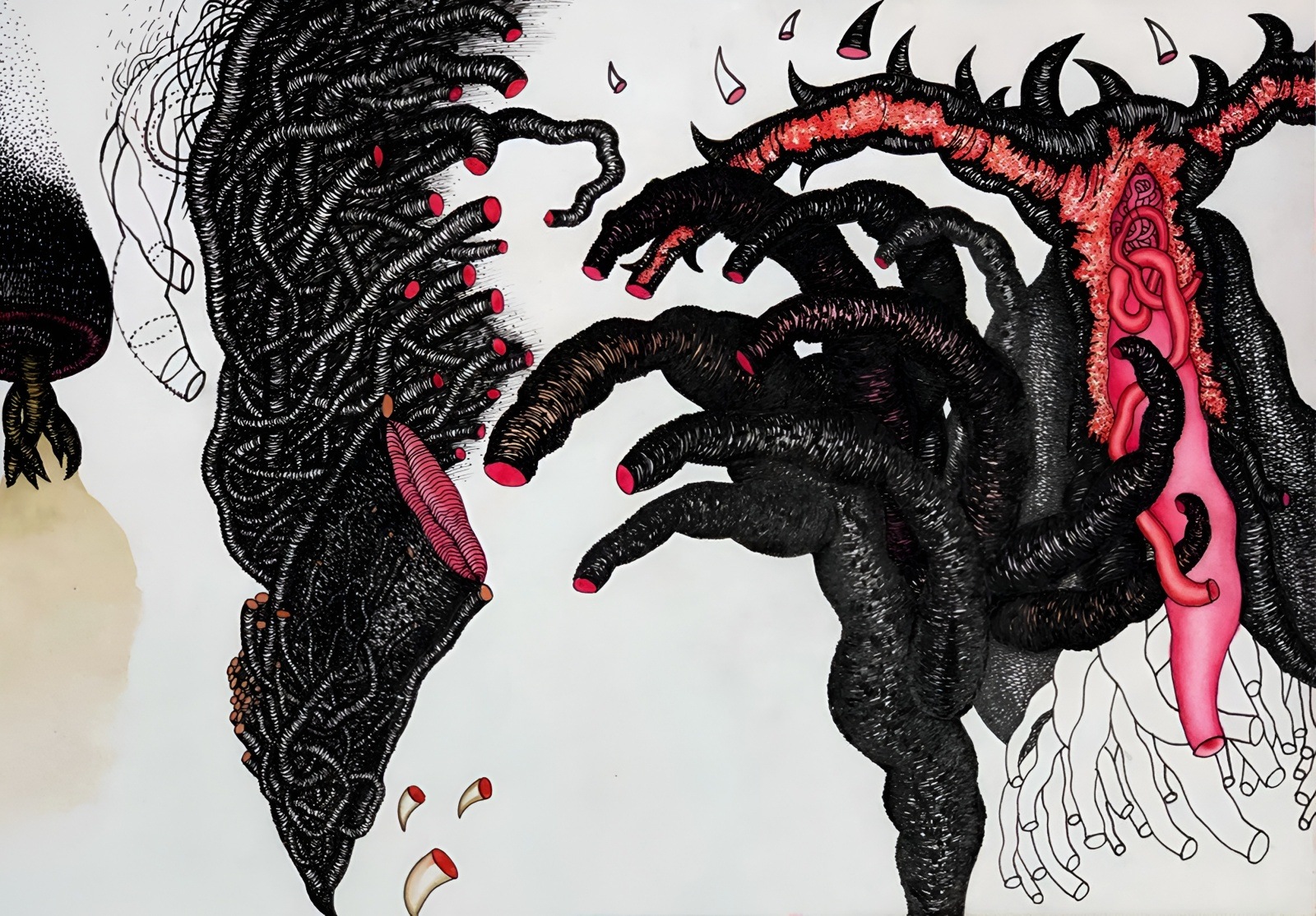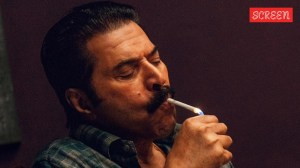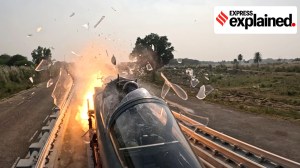‘The work strives to be a violent disruption of the normalisation of life in the wake of trauma’: Sri Lankan artist Pushpakanthan Pakkiyarajah
In his debut solo in India, Pakkiyarajah retells regional stories rooted in a territory that has witnessed decades of Civil War
 "I feel and believe that my body is a studio where I work through ideas, stories and emotions before transmuting them to paper, canvas, or any other medium " : Pushpakanthan Pakkiyarajah (Source: Pushpakanthan Pakkiyarajah)
"I feel and believe that my body is a studio where I work through ideas, stories and emotions before transmuting them to paper, canvas, or any other medium " : Pushpakanthan Pakkiyarajah (Source: Pushpakanthan Pakkiyarajah)In a note on your work, you state: ‘There is no race, colour, or creed in flowers… Flowers never cause strife or devastation; instead, they quietly offer beauty and meaning as they bloom.’ If you could talk about the ‘wounded flowers’ as metaphors of despair in your work.
Wounded flowers from “No Race-No Colour” are an expression — an abstract lament — of systematic ruin, human slaughter, and the hopelessness that looms over our future. The audience can sense that most of the work from the show is marked by wounds — flowers, charred or bloodied. It embodies the universal struggle of all oppressed individuals without prejudice, transcending colour, gender or ethnicity. It looks for areas of vulnerability where people can connect. I use dead and decaying flowers as metaphors for both nature and the human body in this exhibition. Flowers remind us of life’s impermanence; their cyclical bloom and fleeting beauty reflect the precarious balance between birth and death. The body of work explores complex emotions and challenges philosophical concepts that all too frequently fall short of bridging our worldwide human divide through these visual analogies. Flowers are a representation of innocence and fragility.
 Pakkiyarajah has used dead and decaying flowers in his artwork as metaphors for both nature and the human body (Courtesy the artist and Experimenter)
Pakkiyarajah has used dead and decaying flowers in his artwork as metaphors for both nature and the human body (Courtesy the artist and Experimenter)
Looking at regional stories through an environmental lens, much of your work evokes how conflict induces trauma across living ecologies, more closely at the destructive impact of Sri Lanka’s prolonged civil war. Could you elaborate on this approach?
In 2014, with a group of artists, I forced myself to walk across the sands of Mullivaikkal beach over the graves of those taken in the final phase of my country’s civil war. I came upon a charred-black album, the photos burned and the faces obscured. With what hopes was this album brought to this place? The album and its memories haunted me. It was an important moment in my artistic practice where I shifted focus from the tragic events of my childhood to something shared within my community. The burned album and its power and agency led me to begin several series of works. These include Burning Memories (2016), Disappearance (2017) and Wounded Landscape (2019).
Also, my ongoing solo has been influenced by those experiences. Grieving and Mycelium II, 2023-2025, displayed on the ground, represents the death of innocent civilians, a charred landscape, and also serves as a monument. There is a stratum between history and erased histories; between landscape, ocean and sky. When you open layers, you can see evidence, witness, and haunted memories that were whitewashed by the side who have power. The work strives to be a violent disruption of the normalisation of life that happens in the wake of trauma, and foregrounds histories of violence to remember the past and engage the present in processes of healing — in Sri Lanka, but also across national borders.
If you could tell us a bit about your formative years in Batticaloa.
Many of my friends have said that they have no memories from childhood, especially before the age of five. On the contrary, I have childhood memories from as early as two years old. My experience of violence began when I was four — when an armed group broke into our home in the middle of the night and killed my father in an adjacent room. I was so young that I did not overthink this tragic event at the time, and neither did I think about how my family would recover from this misfortune. When I joined pre-school, I was pushed to answer the questions: What is your father’s name? Where is he? What is he doing? I cried plenty of times and tried my best to avoid those questions in the future.
 Blooded flowerscape is a part of the artist’s solo exhibition “No Race, No Colour” at Experimenter Gallery in Kolkata (Courtesy: Pushpakanthan Pakkiyarajah and Experiementer)
Blooded flowerscape is a part of the artist’s solo exhibition “No Race, No Colour” at Experimenter Gallery in Kolkata (Courtesy: Pushpakanthan Pakkiyarajah and Experiementer)
These memories made me scared and shy as I continued to grow up. Because we were a middle-class family, I didn’t have many ways to entertain or distract myself; so my siblings and I began to draw. This became a wonderful hobby that we enjoyed, and this is also the beginning of my art practice. However, I did not realise that trauma influenced my artwork until I became a teenager. By the beginning of my undergraduate studies, my fundamental materials were paper, canvas, and mixed media. I studied art and design at the University of Jaffna, and this programme introduced me to a broader network of South Asian and Western artists. And this introduction to the broader network inspired me to work hard. When I learned art history, it became clear to me that I would become an artist.
After my graduation in 2014, I began more experiments to understand the relationship between my materials and my emotions; this included working in various mediums such as digital, video and sculpture. Though I approached my practices as healing, I began challenging myself to make meaningful connections with other contemporary artists and institutions. Later, overseas opportunities and graduate study at the University of Illinois in Chicago on a Fulbright scholarship helped me to explore and exchange knowledge, and open many doors to share the marginalised stories across the world.
In your art practice, there is a strong emphasis on materials of creation. For instance, in Straddling Ocean and Sky (2021-2022), you worked with thousands of found images, video stills and drawings to create a four-minute assemblage that plays on a loop. The ongoing exhibition sees materials such as rope, hardened cloth and wood dust. Can you talk about the significance of material aesthetics in your works?
I feel and believe that my body is a studio where I work through ideas, stories and emotions before transmuting them to paper, canvas, or any other medium. Whenever you travel physically or in memory, it comes with observations and experiences to express. Before I firmly accepted and believed that my body is a studio, I had a question: What does my body mean? How can I say my body has been designed by nature? That is where I struggle to define the body and separate the body from nature or any other elements or circumstances my body experienced and lived through. Also, new materials and the work itself ask for more active engagement with the body.
 “Wounded flowers” artwork is made of steel rod, hardware cloth, cotton rope, wood dust, thread, wood glue, fluid matte medium, acrylic, emulsion, wood preservative and automotive enamel (Courtesy: Pushpakanthan Pakkiyarajah and Experiementer)
“Wounded flowers” artwork is made of steel rod, hardware cloth, cotton rope, wood dust, thread, wood glue, fluid matte medium, acrylic, emulsion, wood preservative and automotive enamel (Courtesy: Pushpakanthan Pakkiyarajah and Experiementer)
I am eagerly experimenting with various materials, and it’s an excellent avenue for further exploration. Different situations create different influences and material choices. For instance, I started to do experimental sculpture at the beginning of 2021. In that process, I had an accident; blood was dripping from my hand and fingers. Afterwards, I could not continue the sculpture and was stuck both physically and mentally. Then my mind started on a journey through some haunting memories from childhood when I saw dried blood and ants under two palmyra trees that were about 30 feet from our house. Both palmyras still exist as silent witnesses to a victim.
I then started to do Photoshop with my village’s nightscape through a photograph I captured about eight years ago. The result of this was about 650 still images that I made into an animation, and I titled it Palmyra. After, I started working on Straddling Ocean and Sky, 2021-2022, a film project which incorporated colonial history into the final war situations in Sri Lanka.
The installation Charred Hyphal Mat (2024–2025) responds to Experimenter’s house architecture, “forming a cloud forest and raising attention to perpetual threat from pyrotechnics of a world on fire”. Could you tell us more?
I was invited by Experimenter to see the Ballygunge Place, when Krishna Reddy’s exhibition was on display last year. It was such a wonderful thing that I had a chance to see Reddy’s work in person also, seeing the architectural space where I exhibited within a year. I wasn’t clear on what I was going to respond to in that space and how I would install them. However, I had some thoughts when I came back to my studio.
 Charred Hyphal Mat (2024–2025) is the largest sculpture that Pushpakanthan Pakkiyarajah has ever made (Courtesy: Pushpakanthan Pakkiyarajah and Experiementer)
Charred Hyphal Mat (2024–2025) is the largest sculpture that Pushpakanthan Pakkiyarajah has ever made (Courtesy: Pushpakanthan Pakkiyarajah and Experiementer)
Charred Hyphal Mat (2024–2025) is the largest sculpture I have ever made. I had no idea how it would work or how the final product would look, but at the same time, I was emotionally processing that work. I was thinking of war zones where innocent civilians are trapped in the war machine, between flimsy ceasefires and illusory peace.
Importantly, I frequently watched and read news from Palestine and I was so overwhelmed and tried to respond to those emotions in this series. So, I wanted to make something that featured charred landscapes, a toxic ocean and the sky. I tried to create a possessed space that could incorporate shadow, mycelium patterns and the sound.
Importantly, Prateek Raja, Priyanka Raja, Anjishnu Banerjee, and their labour assistance supported a lot with that installation. Moreover, the collective trauma and materials are well-connected to each other. Likewise, I believe I am not invisible and am not singular; my work and the content are a plurality.
The works gain an ecological dimension through the usage of mycelium as a symbol for healing and connectivity. Human societies rely on shared histories and collaborative efforts to overcome trauma, much like trees rely on mycelial networks to survive. In order to overcome the legacies of violence and marginalisation, this parallel emphasises the importance of solidarity and collective responsibility. As a result, the body of work functions both as a memorial and a call to action, urging viewers to recognise their role in driving meaningful change.
- 01
- 02
- 03
- 04
- 05































